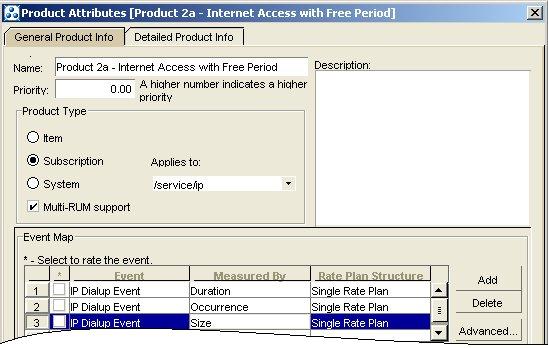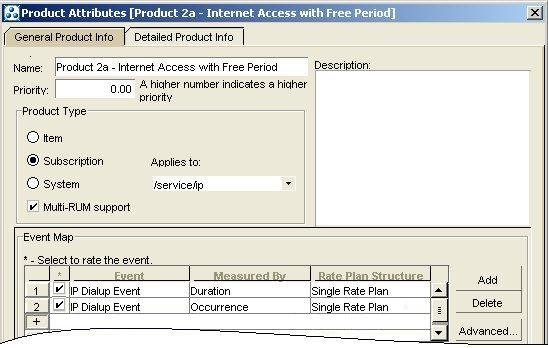12 Real-Time Rating Based on Multiple RUMs
This chapter shows how to use Oracle Communications Billing and Revenue Management (BRM) to set up products to rate events based on multiple ratable usage metrics (RUMs).
Before you read this chapter you should be familiar with rating and price lists. See "About Creating a Price List".
About Rating Based on Multiple RUMs
By default, BRM rates an event by using a single RUM that is specified in the product's usage map. You can also set up your products to rate an event based on multiple RUMs. For example, you can set up a Session Event with both Occurrence and Duration selected as RUMs by which the event is measured.
To rate an event by using multiple RUMs, you map the event to the RUMs in the product's usage map.
Figure 12-1 shows the Multi-RUM support option selected and multiple IP Dialup events with different RUMs defined:
Figure 12-1 Multi-RUM Support for IP Dialup Event

Description of ''Figure 12-1 Multi-RUM Support for IP Dialup Event''
To apply the RUMs, you map the event to the RUMs and the rate plan in the product's usage map.
Figure 12-2 shows a usage map for an Internet Access product with two IP Dialup events mapped to Duration and Occurrence, with both events selected for rating:
Figure 12-2 Rating IP Dialup Events Using Duration and Occurrence

Description of ''Figure 12-2 Rating IP Dialup Events Using Duration and Occurrence''
For each event to be rated, click the check box in the * column, located between the event number column and the Event column.
Important:
Specifying multiple RUMS for the same event type and selecting events to be rated are two separate functions, each handled in the Event Map.When an event is rated using multiple RUMs, a balance impact is applied for each RUM per each resource. For example, if two resources are impacted, two separate balance impacts are created.
For information about setting up products with multiple RUMs, see "Applying Multiple RUMs to Rate an Event".
Applying Multiple RUMs to Rate an Event
To rate an event by using multiple RUMs, you map the event to the RUMs in the product's usage map.
To use multiple RUMs to rate an event, you do the following:
-
Define the RUMs available for rating. See "About Ratable Usage Metrics".
-
Map the event to the RUMs in the product's usage map. See "Example of Mapping an Event to Multiple RUMs".
Example of Mapping an Event to Multiple RUMs
When you create a product, you specify the events to rate for the service, and the rate plans that determine how to charge for those events. To rate an event by using multiple RUMs, you associate the event with the RUMs and the rate plans.
You can map the same event to multiple RUMs by using different rate plans. For example, you can specify a rate plan to charge for a fax event based on the number of pages faxed and another rate plan to charge based on the duration of the fax session.
To map an event to RUMs:
-
Specify the RUMs in the product's usage map.
In Figure 12-3, two IP Dialup events are mapped to Duration and Occurrence with different rate plans, with both events selected for rating:
Figure 12-3 Multiple RUM Event Mapping Example

Description of ''Figure 12-3 Multiple RUM Event Mapping Example''
-
Indicate the events to be rated by clicking the check box in the * column, located between the event number column and the event type column.
-
When you finish creating products, deals, and plans, commit your price list to the BRM database.